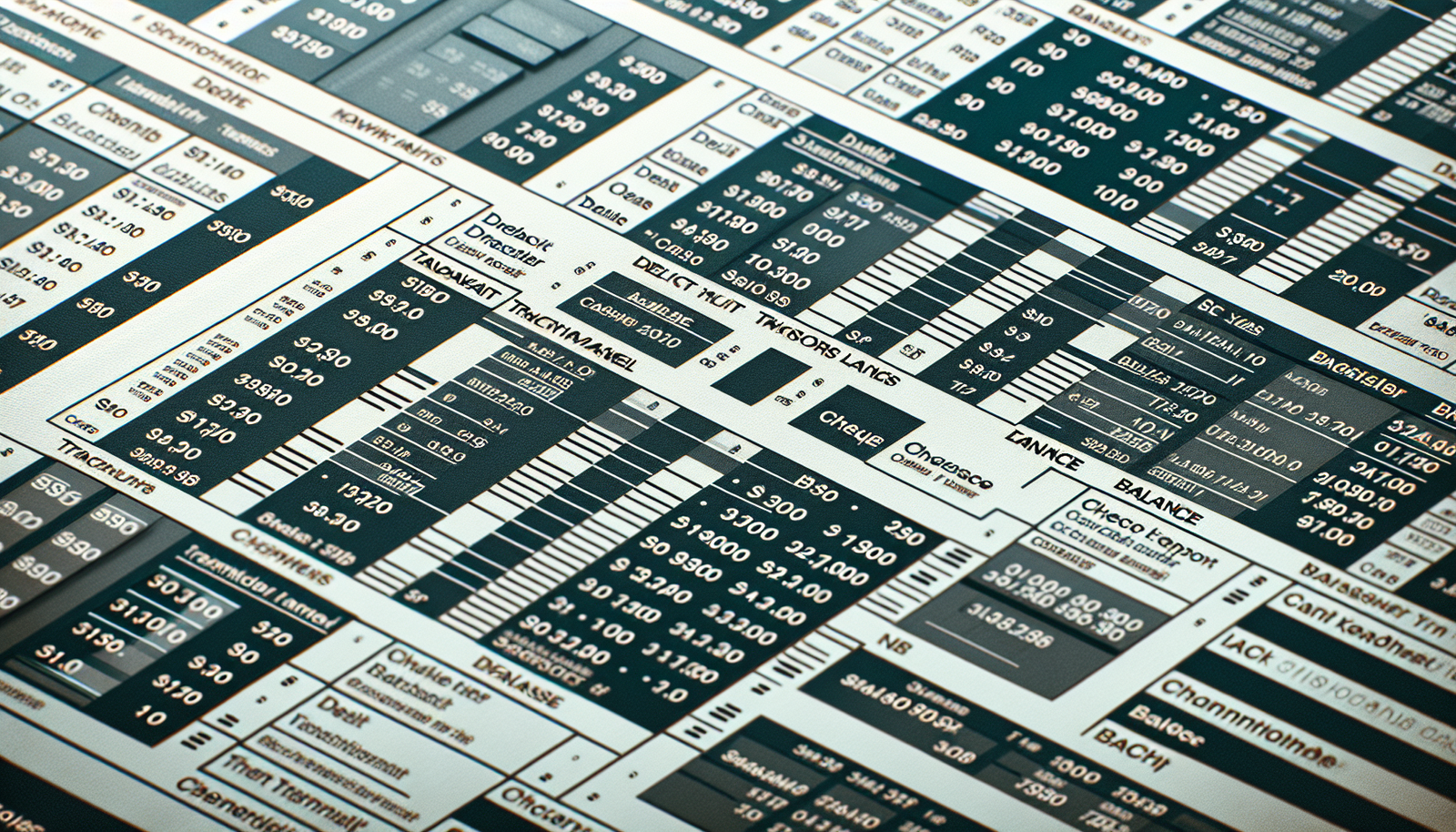
Imagine stepping onto an open stage, the spotlight centered on you, as you unfurl your bank transaction statement like an intricate map of your financial journey. Through the highs and lows, this intricate dance of numbers and balances, reveals a narrative of your fiscal habits and behavior. In this grand performance to unfold titled “Bank Transaction Statement,” you’ll navigate your way through these intricacies, gain insights, and perhaps even reach a new level of awareness of your spending habits and financial health. Allow yourself to be the protagonist in this compelling narrative of your own financial story.

Understanding Bank Transaction Statements
Definition of bank transaction statements
A bank transaction statement, often referred to as a bank statement, is a summarized record of your financial activities for a specified period. It vividly captures your account’s in-goings and out-goings, showing details like deposited amounts, withdrawn sums, account balance, fees and charges, and interest earnings. Undoubtedly, it is a trustworthy torchlight that brightens your financial journey and supports you in navigating your fiscal life.
The importance of bank transaction statements
Bank transaction statements offer more than just a list of transactions; they are an essential tool for managing your finances effectively. You can use your statements to track your spending, identify any fraudulent activities, verify transactions, and understand the fees and charges associated with your account. Moreover, these statements provide vital information for filing tax returns and preparing financial reports. Hence, you can firmly consider them as your financial health report!
How bank transaction statements are generated
Bank transaction statements are typically generated by your bank’s computer systems, capturing every transaction processed through your account. Be it deposits, withdrawals, transfers, ATM usage, online purchases, interest earnings, or fees charged – each activity is recorded in real-time. All these data are then collated and organized into a statement at the end of a specific period, often monthly, and sent to you in your preferred format.
Elements of a Bank Transaction Statement
Account holder information
This includes your name, address, and sometimes phone number – basically, all the personal identifiers that collectively confirm your ownership of the account. These details are usually printed at the top of the statement to facilitate easy identification.
Date of statement
The date of the statement is the period the statement covers, marking the start and end dates of the transactions recorded. It is imperative for associating the transactions with the correct timeframe.
Account number
Your unique account number is also highlighted. It helps guide you to the specific account in case you hold multiple accounts with the bank.
Transaction details
This section shows the chronology of your banking activity during the defined period. It lists both incoming (credits) and outgoing (debits) transactions along with their amounts and dates.
Balance details
Balance details display the opening and closing balance for the statement period. It also mirrors your account’s financial status at the beginning and end of the timeframe.
Types of Bank Transaction Statements
Monthly statements
Monthly statements are the most common type, providing updates on your account activities every month.
Quarterly statements
These are generated every three months, and may be preferred by those with lesser transaction volumes or those looking for a broader overview of their finances.
Annual statements
As the name suggests, annual statements are yearly reports. They might be more useful for tax filing or longer-term financial planning.
Event-driven statements
These are non-periodic, ad-hoc statements generated on a need basis. It could be generated due to a large deposit or withdrawal, a suspicious transaction, or any activity that significantly impacts your account balance.
Understanding Transaction Types
Debit Transactions
Debit transactions represent the money leaving your account. They could occur due to bill payments, checks written, ATM withdrawals, among other events.
Credit Transactions
Credit transactions reflect the money coming into your account. They could arise from deposits, automatic transfers, direct payments from your employer, or any other incoming funds.
Electronic Fund Transfers
These are transactions triggered electronically, typically online or over the phone. They could be bill payments, money transfers to different accounts, or payments to other parties.
ATM Withdrawals
ATM withdrawals are self-explanatory. Any cash withdrawn from an ATM is recorded as a debit transaction.
Point Of Sale Transactions
These represent purchases made using your debit or credit card at a shop, restaurant, or similar physical locations.

Deciphering Your Bank Transaction Statement
Tracking spending
Your bank statement is a great tool for monitoring your spending. By studying your transaction history, you can understand where your money goes and help curate an effective budget plan.
Identifying discrepancies
Cross-checking your statement with your personal records can help you spot any inconsistencies or errors.
Understanding fees and charges
Your statement lists any fees or charges associated with your account. Understanding these elements is crucial to managing your account wisely.
Being aware of fraudulent activities
Early detection of unauthorized transactions or suspicious activities is key to maintaining your account’s integrity, and your bank statement is a vital tool in this regard.
How to Request a Bank Transaction Statement
Through the online banking portal
With most banks offering online services, you can easily request your bank statement through the bank’s internet banking portal.
Via mobile banking apps
In today’s digital era, your mobile banking app is another handy tool for requesting your statement conveniently.
By visiting the bank branch
For those who prefer face-to-face interactions, you can visit your bank branch and request your statement from a bank representative.
Through ATM
Certain banks offer the option to print transaction statements directly from their ATMs.
Common Errors in Bank Transaction Statements
Accounting errors
Accounting errors, like incorrect amounts or transactions not recorded, can sometimes occur.
Technical glitches
Glitches in the bank’s computer system might sometimes cause discrepancies in your bank statement.
Errors due to identity theft and fraud
Illegal activities or fraud can lead to unauthorized transactions appearing on your statement.
Banking process errors
Errors might also arise due to misoperations in banking processes, such as deposits credited to the wrong account or double charging for a single transaction.
Resolving Errors in Bank Transaction Statements
Contacting customer service
The first step in resolving errors is to contact your bank’s customer service team. They can guide you on the necessary measures to correct the discrepancies.
Visiting the bank
In some cases, you might need to visit the bank branch to resolve the error, especially if it’s a larger issue or requires additional clarification.
Legal actions
If the discrepancy is due to fraudulent activities or identity theft, it might necessitate reporting to the police and other legal measures.
Benefits of Regularly Reviewing Bank Transaction Statements
Improved financial management
Regularly reviewing your bank statement can help you manage your finances better. You’ll be up-to-date with your income and expenditures and can make informed financial decisions.
Early detection of fraud
Regular review aids in detecting any fraudulent or suspicious activities early on, enabling swift action to secure your account.
Avoidance of unnecessary fees
By understanding the fees and charges listed on your statement, you can avoid unnecessary costs and potentially save money.
Accurate tax reporting
With the wealth of financial information found in your bank statement, it becomes easier to file accurate and timely tax returns.
Online Vs. Paper Bank Transaction Statements
Convenience of online statements
Online statements are easily accessible anywhere and anytime. They’re fast, efficient, and best suited for today’s digital lifestyle.
Physical access and tangibility of paper statements
Meanwhile, paper statements provide a tangible record that can be physically filed and accessed even during internet downtime.
Environmental impacts of both methods
While paper statements contribute to deforestation and environmental pollution, online statements are eco-friendly, requiring no tree-cutting or paper waste.
Security concerns
While online statements tend to be more secured and don’t risk being lost or stolen, they also depend on strong cybersecurity practices to prevent hacking or digital theft. Conversely, paper statements, while not susceptible to cyber theft, could be lost, stolen, or damaged.
In conclusion, bank transaction statements are much more than mere papers or digital documents – they’re your financial diaries, your fiscal guides. Therefore, appreciate them, understand them, scrutinize them and make them part of your regular financial planning process!

